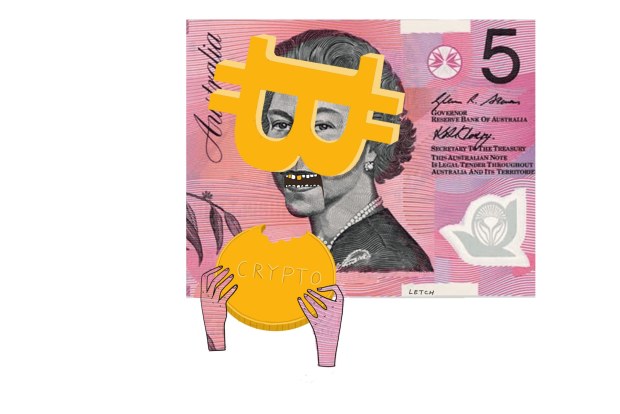Zero cash rates may have been a key driver of the appeal of non-income producing assets like bitcoin.
It turns out 2021 was not the panacea to the pandemic we all hoped for. While we made progress, COVID-19 continued to influence life as we know it through variants like delta and omicron, which required ongoing restrictions.
Although the persistence of the pandemic is disappointing, the last 12 months have nonetheless offered important lessons.
On a personal level, one particularly interesting insight was provided by Ken Griffin, the talented founder of the US hedge fund and market-maker, Citadel. This column has been resistant to writing about crypto because I am no subject-matter expert.
But tradeable asset classes like crypto are of tremendous interest to the world’s biggest market-maker. And it was surprising to hear how sceptical Griffin was about bitcoin and other digital surrogates for conventional currencies.

Griffin explained his doubt as follows. First, he thought it was hard to accurately value a security that produces no income. Commodities such as gold have similar properties, although they have value as precious metals used in commercial products.
Second, Griffin noted that bitcoin appears to be extremely expensive (over $US51,200 right now) for the service it provides, which is a very volatile (read unreliable) store of wealth and imperfect medium of exchange. You cannot as yet buy much with bitcoin or ethereum.
He argued that while cryptocurrencies have been around for some time, they are not especially functional as substitutes for our payment system (ie, alternatives to banks, cash and credit/debit cards). If you lose your credit card, or suffer fraud, you know the bank will make you whole. But lose your bitcoin and bad luck.
This brought Griffin to the point that the value of currencies like the US dollar as a store of wealth and medium of exchange is backed by the power (in all its forms) of the sovereign standing behind it.
In contrast, bitcoin is a non-guaranteed digital security created by unknown originators, which may or may not be impervious to threats to its encryption and globally distributed ledger.
And what is to prevent nations starting their own digital currencies, as the Chinese are doing, Griffin queried. He further threw shade on blockchain, claiming that for all its prospects it had not been successful in replacing the parts of the financial system that its proponents had for years targeted.
Finally, Griffin observed that most asset classes have experienced tremendous inflation since the pandemic as a result of zero interest rate policies and digital money printing by central banks. A helpful corollary was slashing the debt-servicing costs of public sectors running record budget deficits.
The enormous cash bequeathed by fiscal policy on to household balance sheets combined with the inability to go out and spend that money in normal ways may have fuelled the retail speculation seen since 2019, which meme stocks and crypto have benefited from.
This triggered several thoughts. Has there been a relationship between bank deposits paying a near-zero return since 2019 and the rise of zero-income digital currencies as a substitute? The opportunity costs are definitely lower when cash offers no return.
Importantly, how will investor behaviours change once cash starts paying positive returns as central banks lift rates in 2022? Would high interest rates on conventional cash kill some of the demand for digital currencies by casting into relief the differences between these non-guaranteed payment mechanisms and sovereign-backed money?
There are credible counter arguments the crypto crew will doubtless tender in response. It is, however, worth considering the other side of this coin! Here I will tender one final thought. Before the pandemic precipitated a sharp reduction in cash rates, bitcoin was trading at $US7500 in December 2019. This was less than half its previous peak of $US19,650 in December 2017. Since 2019, it has leapt over 580 per cent…
What else did we learn in 2021? We have transitioned from fears of deflation and disinflation induced by the recession to worries that we may now be grappling with persistently high inflation. The latest US data only amplified these anxieties. The Fed’s preferred measure of core inflation printed at a huge 0.5 per cent in November, lifting the annual rate to 4.7 per cent (more than double the Fed’s target).
We have not faced wage/inflation pressures like this in the US since the early 1990s when interest rates were in double-digit territory. Even more disturbingly, there is evidence that consumer inflation expectations may have become de-anchored from the central banks’ 2 per cent targets: in the US, expectations are at their highest levels since the early 1990s save for a brief spike around the global financial crisis.
There is no modern precedent for the coincidence of zero interest rates and extreme money printing, on the one hand, and very high core inflation, wage growth, inflation expectations and full employment, on the other.
The initial catalyst was the shock to supply chains from COVID-19. Further mutations like omicron are driving additional waves of restrictions.
The decoupling of supply chains from China on security grounds exacerbates these cost pressures. Then overlay the influence of environmental filters that deny capital to fossil fuel industries, hampering investments in traditional energy supplies at a time when we cannot costlessly transition to cleaner options.
So while inflation might be transitory, the truth is, as Lloyd Blankfein recently exclaimed, nobody knows. And the longer it lasts, the greater the risk it becomes entrenched. Given the complexity of the economy, forecasting inflation beyond 12 months is impossible. The persistence of inflation and what it means for higher interest rates and lower asset prices remains the big “known unknown” for 2022.

What we do know is that central banks have started slowly unwinding their stimulus. My colleague Kieran Davies writes that six out of 17 advanced economy central banks have begun lifting rates. Across emerging markets, the ratio is higher, with 10 of the 21 central banks raising rates.
The question is how quickly cash rates actually climb. With the US jobless rate heading towards 3-point-something-per-cent, it is hard to believe the Fed will only lift its policy rate three times next year when it is sitting at the zero lower-bound juxtaposed against a neutral cash rate of 2.5 per cent.
Full employment coupled with secular global inflation implies central banks are behind the curve, which could compel them to play catch-up. And while they have the tools to crush inflation, doing so could drive another deep recession.
This year certainly presented one case study of what can go wrong when a central bank tries to exit unconventional policies too quickly.
After the Reserve Bank of Australia suddenly dumped two key policy platforms in November – the 3-year government bond yield target and its long-term forward guidance – following one decent quarterly core inflation print, Aussies were hammered with up to 100 basis points of increases in their fixed-rate borrowing costs. And illiquidity gripped the futures and swaps markets.
In 2021 we did see some governments make bold decisions. At home, the Commonwealth remarkably committed to a new military alliance (AUKUS) to enable the acquisition of nuclear submarines, a cause this column has advocated for almost a decade.
While security experts correctly questioned when the boats will actually arrive, it is a step in the right direction to secure Australia against the threat of existential conflicts. (We published our own research showing how artificial intelligence and hundreds of years of data can be used to better handicap the probability of these conflicts materialising.)
We also saw the power of two politicians, NSW Premier Dominic Perrottet and Treasurer Matt Kean, presciently using $11 billion of savings they had prudently set aside for fiscal crises to pre-emptively repay taxpayer debt at a time when the budget was being butchered by the pandemic. This had never been done before.
Kean was, in fact, able to downgrade NSW debt issuance by an amazing $20 billion from what banks forecast he would have to raise by leaning on his Debt Retirement Fund, which was created by Perrottet for precisely this purpose.
This initiative was facilitated by bipartisan support from one of the hardest-working and smartest politicians in the land, NSW’s shadow treasurer Daniel Mookhey, who alongside his Princeton-educated leader, the telegenic former fireman Chris Minns, will give Perrottet and Kean a run for their money at the next election.
In 2021 we learnt what life is like living without the world’s most powerful country in the capricious hands of Donald Trump, although with Biden looking like a dead man walking, Trump may rise again.
And we were once again schooled on the resilience and ingenuity of the human condition, with NSW and Victoria stunning doomsayers with world-leading vaccination rates approaching 95 per cent of the eligible population, allowing their lockdowns to end faster than had been expected.
Here’s hoping 2022 is a happier new year.
Read full story on Financial Review



